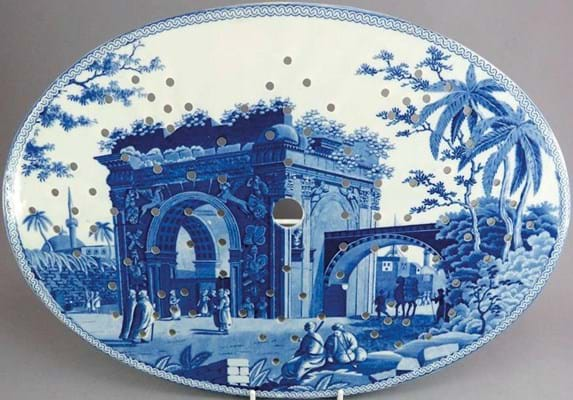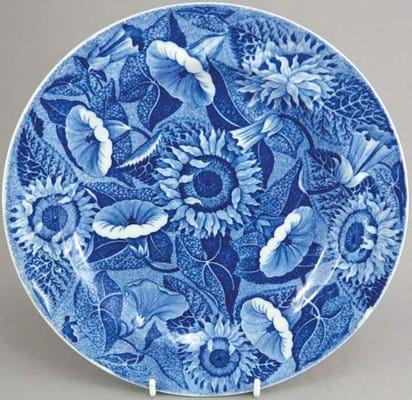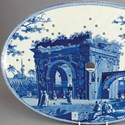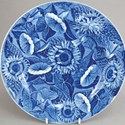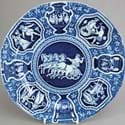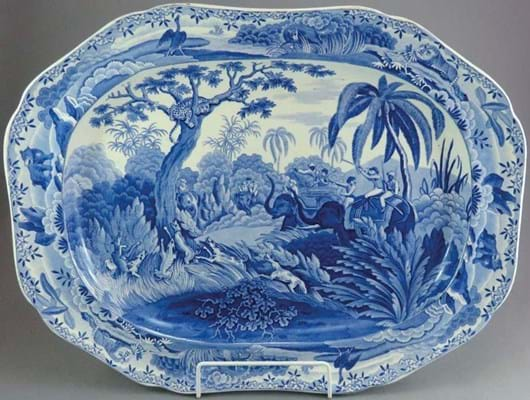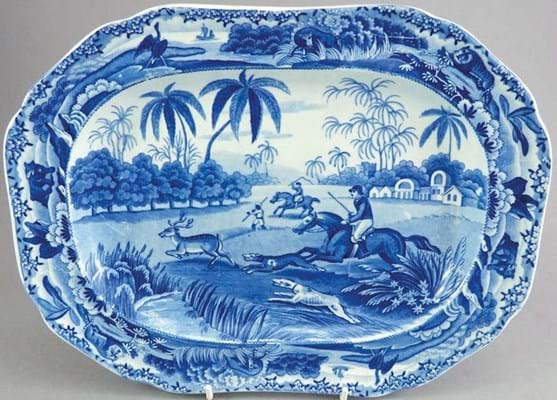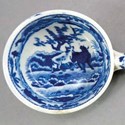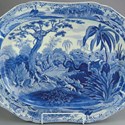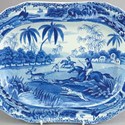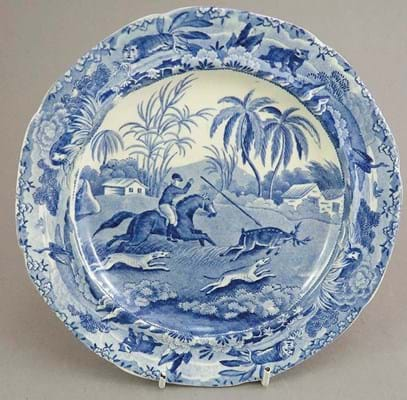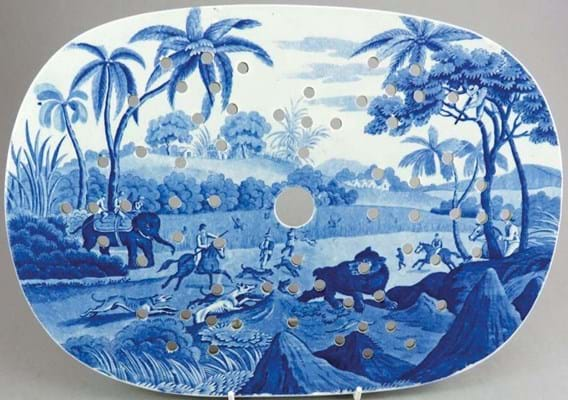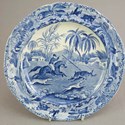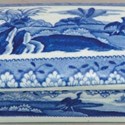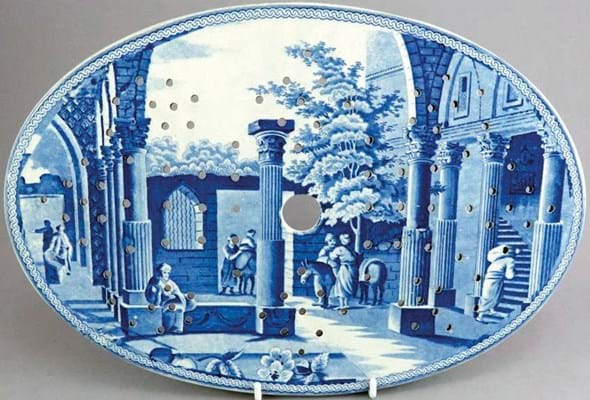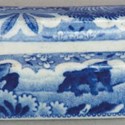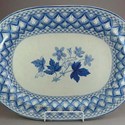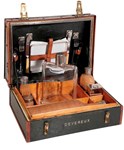It was made from c.1815 until shortly after the onset of the Copeland & Garrett era in 1833. The popularity of the series can be judged by the fact that it was copied almost in its entirety by other potters.
These exotic designs of colonial life in the sub-continent have traditionally been particularly favoured in the US and accordingly operate at an altogether different price level to most transfer printed wares.
At the top of the market 20 years ago, dinner plates ran at £150-300 each and it was not too unusual for a large pearlware meat dish with a title such as Hunting a Civet Cat or Battle between a Buffalo and a Tiger to change hands for more than £2000.
Return to form
In the context of a more difficult market (one in which many 19th century ceramics have fallen off a financial cliff), the sums generated at Hansons (25% buyer’s premium) in Bishton Hall, Staffordshire, on September 30 represented something of a return to form.
This single-owner collection of predominantly early (pre-1833) Spode wares had been assembled by the late Somerset vendor in a condition-conscious manner from the 1960s into the 1990s.
Attracting what specialist cataloguer (and Spode Museum trustee) Dr Richard Halliday called “brisk bidding from every corner of the world” – specifically trade and collectors from the UK, US, Canada, Australia, New Zealand and Italy – some prices would certainly be difficult to replicate in the retail environment.
The top-selling lot was a 11½in (29cm) meat dish crisply printed with the scene titled verso Hunting a Hog Deer. It was pitched at £500-700 but made £2700. When Dreweatts sold the David Drakard collection in 2003 – probably the last equivalent array of Indian Sporting series wares – a lozenge-shaped dish in this design had topped the sale at £2000.
In total eight pieces made £1000 or more, five of which went to bidders on thesaleroom.com.
A 16in (43cm) platter titled Driving a Bear Out of Sugar Canes sold at £1400 with a scarcer 13in (33cm) drainer in the same design bringing £2600. A 13in (32cm) Hunting a Buffalo platter sold at £1400 with an 11½in (29cm) drainer selling for £1200.
A 20in (51cm) Shooting a Leopard meat dish with the printed mark Copeland & Garrett, Late Spode for c.1833 sold at £1450. It was a stronger bid than others of this size have made of late – as recently as March another (with a circumference crack) took £300 as part of the Sir William Whitfield collection. However, back in 2001 another had sold at Dreweatts for £3300.
Rare shapes
Uncommon shapes typically command a premium. Here, a hot water plate printed with the Death of a Bear sold for £550, a razor box at £400 and a single knife rest at £220. Tea plates printed with Groom Leading Out (estimate £100-150) and The Hog Deer at Bay (estimate £200-300) sold at £190 and £360 respectively.
Plates in these patterns had brought £360 and £500 each as part of the Drakard collection.
Bringing the sale to a close was a set of six of the original 40 aquatints from Oriental Field Sports as issued by Edward Orme of Bond Street in 1807. Titled Shooting a Leopard in a Tree, Groom Leading Out, Dooreahs Leading Out Dogs, Death of a Bear, Driving a Bear out of Sugar Canes and Shooting at the edge of the Jungle, they took £420.
First introduced c.1809, the Caramanian series represents Spode’s second most popular early 19th century pattern. It borrowed some of the border designs from Oriental Field Sports but the central scenes were taken from the second volume of a three-part work entitled Views in Egypt, Palestine and the Ottoman Empire published in 1803.
Pieces in this pattern have risen as high as £5000 for a two-handled 10in (25cm) pot pourri sold by Clevedon Auctions in Bristol in 2003.
Hansons’ collection was pretty comprehensive. A dozen designs from the series was represented although (unlike the Indian Sporting series) the Caramanian patterns are not named on the pieces themselves and instead are gleaned from the source prints.
Caramanian dinner plates patterns are not too difficult to find (selling here at around £60-100 a pair).
However, a succession of strong prices came for drainers including one 17in (43cm) example printed with the Triumphal Arch of Tripoli in Barbary sold at £600 and another at 13in (33cm) with Antique Fragments at Limisso (£500).
A Caramanian series sauce ladle is a scarce object in good condition – here one sold at £220 – while bids of £120 and £180 appeared respectively for a small plate depicting the Ancient Granary at Cacamo and a pudding bowl with Ancient Bath at Cacamo.
Of course, these pieces represent a fraction of the output of the Spode factory and blue and white transfer printed wares – most of them the stuff of two and modest three-figure sums. Nonetheless, Halliday resisted the temptation to parcel up the less commercial pieces into large group lots.
It was doubtless welcomed by collectors who, as recent correspondence to ATG suggests, seldom appreciate buying and shipping 10 pieces when only one in the lot is desired.
Under £100
It did mean plenty of lots sold for under £100. These included early 19th century pieces in the factory’s two most successful blue and white designs: the Tower and Castle patterns that were applied to almost all of the factory’s domestic range.
Both are derived from illustrations in Merigot’s Views of Rome and its Vicinity published c.1796-98 – Tower depicting the Bridge of Salaro near Porta Salara and Castle the Gate of Sebastian at Capena.
A Tower mug sold at £25, the same sum achieved by a 10½n (26cm) fluted oval dessert dish in the Castle design.


